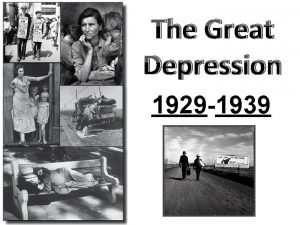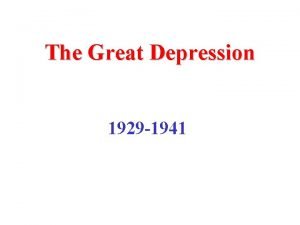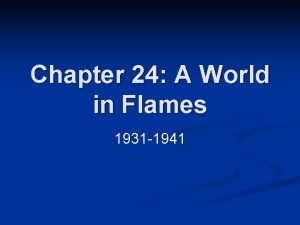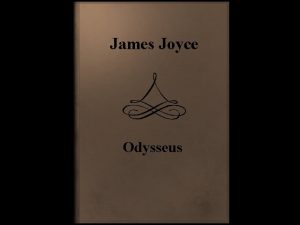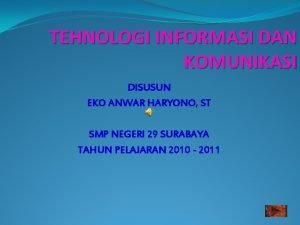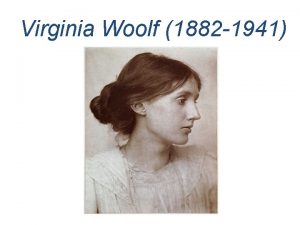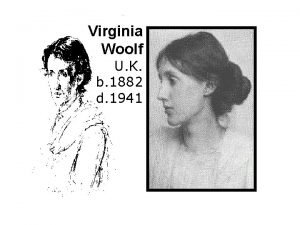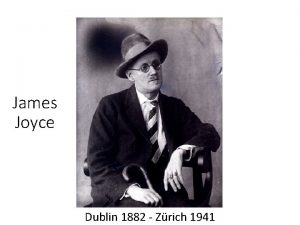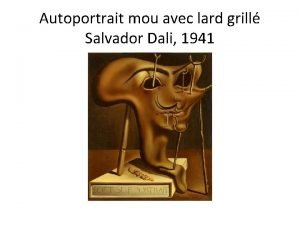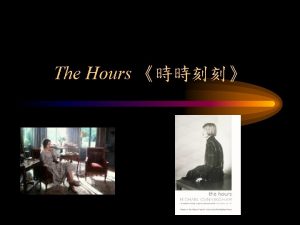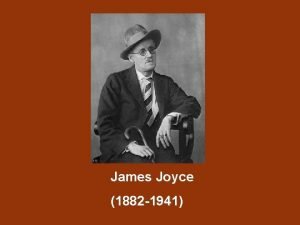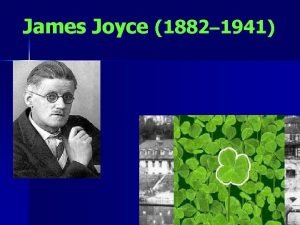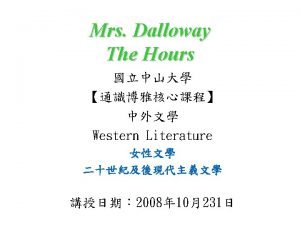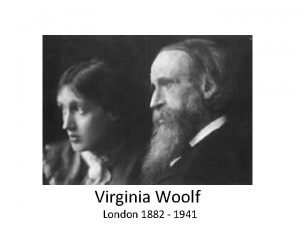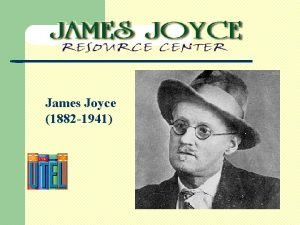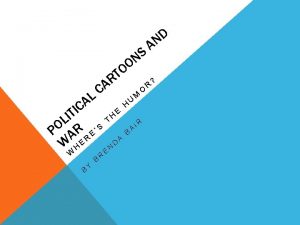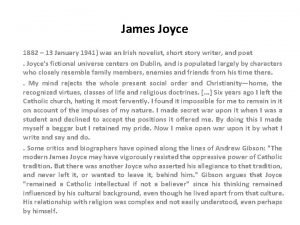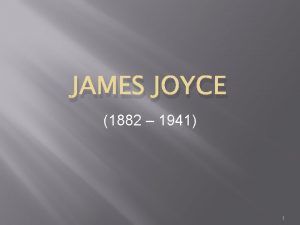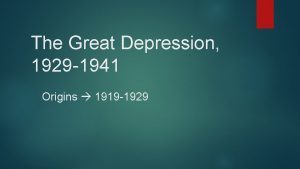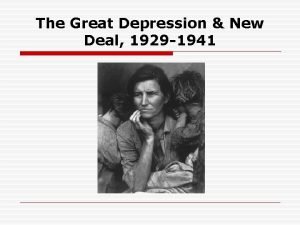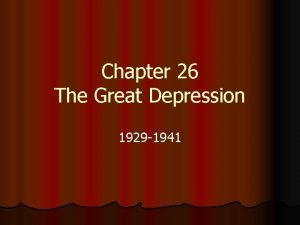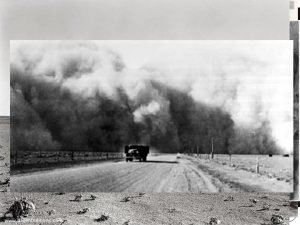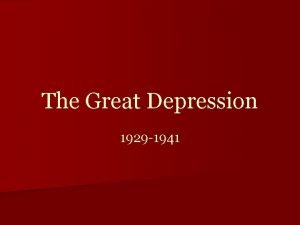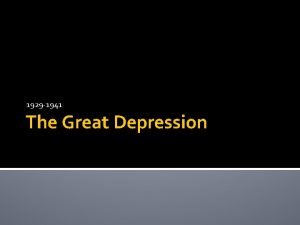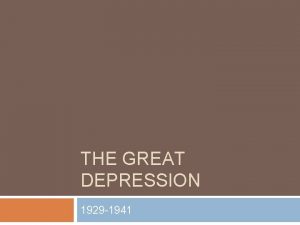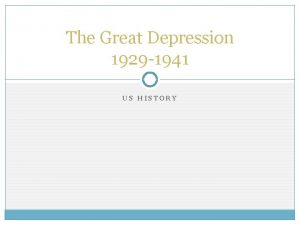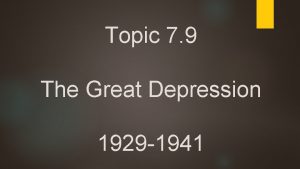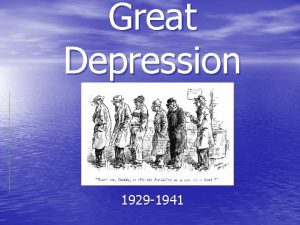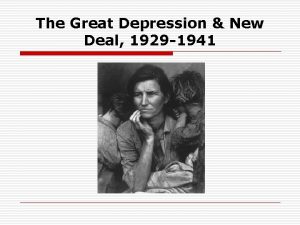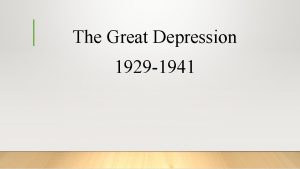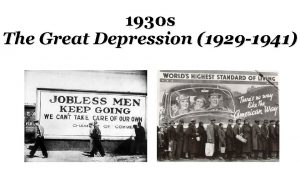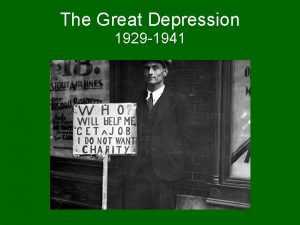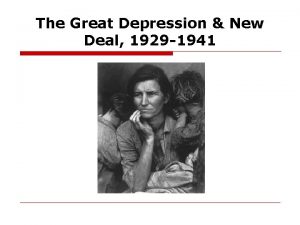The Great Depression 1929 1941 The Great Depression























- Slides: 23

The Great Depression 1929 -1941

The Great Depression 1929— 1941 Learning Objective: What were the causes and effects of the Great Depression? http: //www. pbs. org/wgbh/americanexperienc e/films/crash/

Vocabulary Terms • • • Alphabet Agencies Black Tuesday Buying on Margin Crop Rotation Depression Dust Bowl Economic Reforms Farm Subsidies Flapper Fireside Chats • • • The Great Migration Hoovervilles Investment Jazz Leisure Activity Migrant Farm Workers New Deal Social Security Act Stock Market Boom & Bust

Alphabet Agencies • Organizations with acronyms for names that helped the unemployed, produced electricity to rural areas, helped with insurance, hired young men to work on conservation projects. • Ex. FERA-Federal Emergency Relief Administration, CCC-Civilian Conservation Corps, WPA-Works Progress Administration

The Great Migration • The movement of 500, 000 African Americans traveled North for better jobs, housing, and lives and to get away from segregation and prejudice.

Black Tuesday October 29 th, 1929, investors sold 16. 4 million shares of stocks at prices much lower than they had been selling for a month earlier. The stocks’ prices fell sharply and the stock market crashed. AKA the Crash of ‘ 29.

Hoovervilles Shantytowns of wretched huts that housed homeless people. They were named for the president, Herbert Hoover, because he was blamed for unemployment, hunger, and homelessness.

Buying on Margin • To pay a small part of a stock’s price and then borrow money to pay for the rest. • Ex. Same as buying on credit with a small down payment and then borrow funds to pay later.

Investment • The outlay of money for income or profit. • Ex. Buying Live ‘Stock’ for the game.

Crop Rotation • When you rotate different crops in one field so that the soil retains important nutrients.

Jazz • A new kind of music in the 1920’s that captured the carefree spirit of the time. The only form of music that originated in the U. S.

Depression • When a nation’s economy busts and everyone is in a bad financial situation. Nobody has money to live. Unemployment rate increases sharply.

Leisure Activity • Fun activities to do in your free time. This is the first time in history when people have extra time on their hands due to technological advancements. • Ex. Baseball, tennis, movies, jazz, radio, talking on the phone, driving, and reading books and magazines.

Dust Bowl As a result of draught, dust damaged farms or crops across 150, 000 square mile regions which covered parts of Kansas, Oklahoma, Texas, Colorado, and New Mexico.

Migrant Farm Workers Farm laborers that traveled from place to place in search of work.

Economic Reforms • President Franklin Roosevelt initiated several agencies that would reform jobs, banking, wages, and agriculture. • Ex. Social Security Act: Provided workers with unemployment insurance and retirement benefits. • Ex. National Recovery Administration: Regulated industry and raised wages and prices.

New Deal • President Franklin Roosevelt’s programs to fight the Great Depression. His plan called the 3 R’s: relief for the hungry and jobless, recovery for agriculture and industry, reforms to change the way the economy worked.

Farm Subsidies • Money from the federal government to help farmers through times of inflation, drought, or hardship to ensure an ample food supply.

Flapper A young woman who embraced and followed the fashion and urban attitudes of the 1920’s. She was radical and willing to try something new. They wore bobbed hair, makeup, and dresses that fell just below the knee.

Social Security Act • The law passed in 1935 that requires workers and employers to make payments into a fund from which they draw a pension after they retire.

Fireside Chats President Franklin Roosevelt gave many radio talks to the citizens of the United States and explained his policies in a warm and friendly manner.

Stock Market A public entity , or loose network of economic transactions, for the trading of company stock.

Boom and Bust • The highs and lows of the business cycle. Booms are the high points and busts are the low points.
 Great depression 1929
Great depression 1929 Stock market crash 1929 cartoon
Stock market crash 1929 cartoon Great stock market crash 1929
Great stock market crash 1929 1941
1941 A world in flames, 1931-1941
A world in flames, 1931-1941 Leopold bloom
Leopold bloom Pada tahun 1941
Pada tahun 1941 1941-1882
1941-1882 Leslie stephen virginia woolf
Leslie stephen virginia woolf 1941-1882
1941-1882 1941-1882
1941-1882 Autoportrait mou de salvador dali
Autoportrait mou de salvador dali Yezhovschina
Yezhovschina Suicide note virginia woolf
Suicide note virginia woolf 1941-1882
1941-1882 1941-1882
1941-1882 1941
1941 1941-1882
1941-1882 1941-1882
1941-1882 1978-1941
1978-1941 Ho hum when he's finished pecking cartoon meaning
Ho hum when he's finished pecking cartoon meaning 1941
1941 1941-1882
1941-1882 1882-1941
1882-1941
